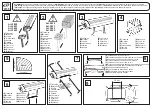
⑥
$:*'LDPP
$:*'LDPP
$:*'LDPP
$:*'LDPP
6XSSO\9ROWDJH9'&
PIW
PIW
PIW
PIW
6XSSO\9ROWDJH9'&
PIW
PIW
PIW
PIW
Cover monitoring
In addition to the standard tamper, this function will latch the
alarm if the cover is opened and will only reset after two
activations. This means if the unit is opened and sabotaged whilst
the system is disarmed, the panel will report an alarm condition
when the system is set.
* After the cover has been opened/closed for setting or inspection,
make the sensor activate twice or more to reset an alarm.
Tamper
This function is used to monitor the status of the cover unit,
attached or removed and issue an alarm against vandalism. If the
cover unit is removed, or improperly mounted, alarm will be issued
by tamper output. When the cover is attached normally, alarm stops.
When an alarm is issued, check the sensor operation immediately.
* When 2 or more units are connected, the wiring distance is calculated
by dividing above value by number of units
:,5,1*
■
Terminal configuration
■
Standard connection
(Connection examples when using two units)
■
Wiring distance between sensor and power supply
Area checker
This function can be used to visually check the sensitive zone in the
detection area by lighting the LED equipped inside the mirror unit.
Self diagnosis
This function is used to monitor errors with detection elements or
sensor circuits, and damaged/disconnected wiring. If damage or
disconnection occurs, alarm will be issued using alarm output and
alarm LED. Reset the power of the sensor during alarm to stop it.
After warming-up operation finishes, monitoring will start again.
When an alarm is issued, check the sensor operation immediately.
Area checker position monitoring
This function is used to issue an alarm using alarm output and
alarm LED when the area checker unit equipped inside the mirror
unit has not returned to the original position.
(Refer to “8 ADJUSTMENT OF DETECTION AREA”)
Low voltage monitoring
This function is used to issue an alarm when the power voltage
level supplied to the sensor decreases abnormally (to approx. 8.5V
or less).
Alarm is issued using alarm output and alarm LED before the
sensor operation becomes unstable.
It works even during the warming-up operation.
When the power voltage level returns to normal during an alarm,
the warning automatically stops. When an alarm is issued, check
the power voltage immediately.
■
Function
)81&7,21
/('FRQWUROLQSXW/&
&RQWUROOLJKWLQJRQRIIRIWKHDODUP/('
&RQQHFWWRWKHSRVLWLYHVLGHRIWKHSRZHUVXSSO\
&RQWUROOHU
3RZHU
RXWSXW
}
6LJQDOLQSXW
6HQVRU
1&
6HQVRU
1&
LED CONTROL FUNCTIONS
Connect terminal
⑤
through an external contact switch with power (+)
■
OPERATION
Turn the DIP switch 1 in Mode selector
①
OFF
When the switch is turned ON, the alarm LED lights at alarm.
When the switch is turned OFF, the alarm LED does not light.
COM
7DPSHURXWSXW
&RQWDFWPHWKRG 'U\PHFKDQLFDOFRQWDFW1&
&RQWDFWRSHUDWLRQ&RQWLQXRXVO\RXWSXWZKHQWKHFRYHULVRSHQ
XQWLOWKHFRYHULVFORVHG
&RQWDFWUDWLQJ
9$&'&$UHVLVWLYHORDG
EXLOWLQFRQWDFWSURWHFWLYHUHVLVWRUї
([WHUQDORXWSXW
&RQWDFWPHWKRG 'U\VHPLFRQGXFWRUFRQWDFW12
&RQWDFWRSHUDWLRQ2QHVKRWRSHUDWLRQVHF2IIGHOD\RSHUDWLRQ
VHF
VHOHFWDEOHZKHQGHWHFWLQJLQWUXVLRQ
(DFKHYHQWRXWSXWLVLVVXHGDVDODUPRXWSXW
&RQWDFWUDWLQJ
9$&'&$UHVLVWLYHORDG
EXLOWLQFRQWDFWSURWHFWLYHUHVLVWRUї
$QWLPDVNLQJRXWSXW
&RQWDFWPHWKRG 'U\VHPLFRQGXFWRUFRQWDFW1&
&RQWDFWRSHUDWLRQ&RQWLQXRVO\RXWSXWZKHQDQREMHFWLV
SODFHGLQIURQWRIWKHOHQVXQWLOQRPDOUHFRYHU\
&RQWDFWUDWLQJ
9$&'&$UHVLVWLYHORDG
EXLOWLQFRQWDFWSURWHFWLYHUHVLVWRUї
3RZHULQSXWQRQSRODULW\
WR9'&0D[P$
$ODUPRXWSXW
&RQWDFWPHWKRG 'U\VHPLFRQGXFWRUFRQWDFW121&VHOHFWDEOH
&RQWDFWRSHUDWLRQ
2QHVKRWRSHUDWLRQVHFZKHQGHWHFWLQJLQWUXVLRQ
&RQWLQXRXVRXWSXWLQWKHHYHQWRIFRYHUPRQLWRUHUURU
XQWLOGHWHFWLRQRSHUDWLRQDIWHUWKHFRYHULVFORVHG
&RQWLQXRXVRXWSXWLQWKHHYHQWRIVHOIGLDJQRVLVHUURU
XQWLOQRUPDOUHFRYHU\
&RQWLQXRXVRXWSXWLQWKHHYHQWRISRZHUYROWDJHHUURU
XQWLOQRUPDOUHFRYHU\
&RQWLQXRXVRXWSXWLQWKHHYHQWRIORQJWHUPGLDJQRVLVHUURU
XQWLOWKHFRYHULVRSHQ
&RQWLQXRXVRXWSXWLQWKHHYHQWRIDUHDFKHFNHUSRVLWLRQHUURU
XQWLOQRUPDOUHFRYHU\
&RQWDFWUDWLQJ
9$&'&$UHVLVWLYHORDG
EXLOWLQFRQWDFWSURWHFWLYHUHVLVWRUї






























